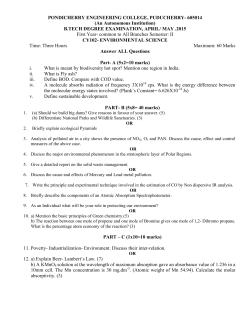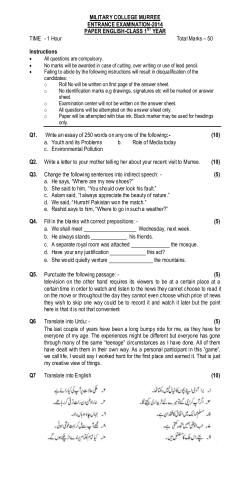
Economics_paper_2__SL
N14/3/ECONO/SP2/ENG/TZ0/XX 88145113 ECONOMICS STANDARD LEVEL PAPER 2 Wednesday 5 November 2014 (morning) 1 hour 30 minutes INSTRUCTIONS TO CANDIDATES Do not open this examination paper until instructed to do so. You are not permitted access to any calculator for this paper. Section A: answer one question. Section B: answer one question. Use fully labelled diagrams and references to the text/data where appropriate. The maximum mark for this examination paper is [40 marks]. 8814-5113 9 pages © International Baccalaureate Organization 2014 N14/3/ECONO/SP2/ENG/TZ0/XX –2– SECTION A Answer one question from this section. 1. Study the extract below and answer the questions that follow. The Australian dollar The Australian dollar is very strong against the United States (US) dollar and has reached its highest value against the British pound and the euro since 1992. The world demand for coal, iron ore, and natural gas is rapidly increasing. Australia has these resources in abundance. This has led to an extraordinary boom in the construction of new mining facilities in Australia that is likely to run for at least 10 years. It has had a huge effect on domestic economic growth and has also threatened inflation. With its stable economic outlook and high interest rates, Australia has proved to be a magnet for foreign investors since 2002, and this has had a significant impact on the exchange rate. The global surge in foreign direct investment and portfolio investment is a sign of international confidence in the economy but it has come at a cost, and with risks. The rise of the exchange rate has created hardships for domestic exporters of goods and services other than resources, and the tourist industry. In the context of the resources boom, the high exchange rate helps to make the boom less inflationary. It also lowers the prices of imports for those consumers and businesses that buy them. Structural change is occurring in the Australian economy as domestic firms adjust to a high Australian dollar. It creates pressure for resources – capital and labour – to shift from manufacturing and service export industries to the expanding mining sector. The result is a change in Australia’s comparative advantage. Everything suggests that the Australian dollar will stay strong, even as export prices increase. The huge spending on mining construction over the years will require a lot of foreign financial capital to flow into Australia, helping keep upward pressure on the exchange rate. [Source: adapted from “All hail mighty Aussie dollar, as it is here to stay”, Sydney Morning Herald, 28 January 2012 and “Aussie Bond Appeal comes at cost”, The West Australian, 27 January 2012] (This question continues on the following page) 8814-5113 –3– N14/3/ECONO/SP2/ENG/TZ0/XX (Question 1 continued) (a)(i) Define the term exchange rate indicated in bold in the text (paragraph ). [2 marks] (ii) Define the term foreign direct investment indicated in bold in the text (paragraph ). [2 marks] (b) Using an appropriate diagram, explain two possible causes of the increase in value of the Australian dollar. [4 marks] (c) Using an AD/AS diagram, explain why “an extraordinary boom in the construction of new mining facilities … has also threatened inflation” (paragraph ). [4 marks] (d) Using information from the text/data and your knowledge of economics, discuss the possible consequences of the strong Australian dollar. [8 marks] 8814-5113 Turn over N14/3/ECONO/SP2/ENG/TZ0/XX –4– 2. Study the extract below and answer the questions that follow. Increase tariff on foreign chicken In the country of Trinidad and Tobago, it has been reported that the price of domestic chicken (poultry) will not increase in the near future, even if the government introduces a higher tariff on imported whole chicken from the United States. The Poultry Association of Trinidad and Tobago (PATT) hosted a news conference to reduce public concerns about reports of an increase in poultry prices. The association says that there will be an increase in prices, but this will only be on imported chicken. However, economists know that this will not be the case. The association is insisting that the current 40 % tariff on imported chicken be increased to 80 % to make things fairer between domestic and imported chicken. They argue that Trinidad and Tobago’s poultry industry has been operating at a major disadvantage in comparison with other Caribbean nations. For instance, Barbados has a 180 % tariff on imported chicken, Jamaica 280 % and Guatemala 257 %. The President of PATT said imported chicken was hurting the local industry, with some firms in danger of shutting down. “Chickens are remaining longer on farms, and it’s not because we want to keep them as pets, it’s because they are not selling,” he said. A domestic poultry producer said the local industry had to compete with goods that came from the United States, the European Union and Brazil, which were heavily subsidized by their governments. “We don’t need subsidies and the government cannot afford to pay us any. We want the tariff. We don’t want to ban imported chicken; once the tariff is on, everything will be fine.” Trinidad and Tobago imports two types of chicken. The first type, “mechanically deboned meat (MDM)”, is used to make processed meat products, such as chicken sausages and chicken burgers. The second type is whole chickens. There is a quota on MDM chickens at 0 % tariff because domestic producers have accepted that they cannot meet the local demand by firms. However, there is a concern that the importers are abusing this tariff-free access to bring whole chicken into the domestic market. Data from customs show that 3.29 million kilograms of chicken was imported in August, but almost 75 % was brought in duty-free. Local chicken sells for approximately $4.50 per kilogram while imported chicken, according to PATT’s information from Customs, is about $1 to $2 per kilogram. “That just covers the cost of shipping the chicken. If these figures are correct, there is something very wrong,” said the domestic producer. The poultry industry makes up 60 % of the agriculture sector in Trinidad and Tobago and generates over 10 000 jobs and $1 billion in revenue. [Source: ©Trinidad Express. Used with permission.] (This question continues on the following page) 8814-5113 –5– N14/3/ECONO/SP2/ENG/TZ0/XX (Question 2 continued) (a)(i) Define the term quota indicated in bold in the text (paragraph ). [2 marks] (ii) List two reasons why the government might wish to protect the domestic poultry industry. [2 marks] (b) Using an appropriate diagram, explain the likely effect that the suggested increase in the tariff (paragraph ) would have on the domestic production of poultry. [4 marks] (c) Using an AD/AS diagram, suggest what will happen to employment if imports continue to damage the domestic poultry industry. [4 marks] (d) Using information from the text/data and your knowledge of economics, discuss the arguments for and against the protection of the domestic poultry market. [8 marks] 8814-5113 Turn over N14/3/ECONO/SP2/ENG/TZ0/XX –6– SECTION B Answer one question from this section. 3. Study the extract and data below and answer the questions that follow. Mozambique to produce its own antiretroviral (ARV) drugs Mozambique’s health minister announced that the first ARV drugs produced in Mozambique, in partnership with Brazil, will be ready by July 2012. In doing so, it will be the first African country – rather than private sector supplier – to produce its own supply of the drug, which can allow people who have HIV to live for many years. Until 2011, a handful of drug multinational corporations have battled to keep in place patents that give drug companies the exclusive right to manufacture and sell the ARV drugs. This has allowed them to control the highly profitable market. Although most African countries aim to provide free ARV drugs to their citizens, the high costs of importing them, along with a recent cut in funding from international foundations, means that many are struggling. A total of 10.6 million people in Sub-Saharan Africa are in need of ARV treatment but only 37 % currently have it. In Mozambique, 15 % of people aged 15 to 49 have HIV. Brazil has been producing its own ARV drugs since 1993 and now provides free versions of the drugs to everyone in the country suffering from HIV. Mozambique is the biggest beneficiary of aid from Brazil, which has invested heavily in its infrastructure, mining, health, agriculture and educational sectors. The health minister signed an agreement with Brazil to co-produce ARV drugs in a factory in the southern city of Matola, Mozambique. Brazil will provide training for Mozambican staff in the production, management and quality control of the drugs. He was pleased because more people in Mozambique will soon have access to the ARV drugs. Other countries in Africa are also taking steps to produce their own drugs. As new international agreements on intellectual property are going to make drugs more expensive, countries are now trying to produce the ARV drugs themselves. This is a positive move for Mozambique. [Source: © Telegraph Media Group Limited 2011] (This question continues on the following page) 8814-5113 N14/3/ECONO/SP2/ENG/TZ0/XX –7– (Question 3 continued) Figure 1 Mozambique and Sub-Saharan Africa – Human Development Index (HDI) figures 2000 to 2011 1.0 0.9 0.8 0.7 0.6 0.5 0.4 0.3 0.2 0.1 0.0 0.401 0.245 0.431 0.438 0.445 0.451 0.456 0.46 0.463 0.285 0.29 0.299 0.304 0.312 0.317 0.322 200020012002200320042005200620072008200920102011 Key: Sub-Saharan Africa Mozambique [Source: http://hdr.undp.org/en/countries/profiles/MOZ] (a)(i) Define the term infrastructure indicated in bold in the text (paragraph ). [2 marks] (ii) With reference to the data in Figure 1, describe the HDI trend for Mozambique from 2000 to 2011. [2 marks] (b) Using an appropriate market failure diagram, explain how externalities arising from a lack of access to ARV drugs may be eliminated by their free provision (paragraph ). [4 marks] (c) Using an appropriate diagram, explain how increased access to ARV drugs might affect potential economic output. [4 marks] (d) Using information from the text/data and your knowledge of economics, evaluate the possible outcomes of Brazil’s aid to Mozambique. [8 marks] 8814-5113 Turn over N14/3/ECONO/SP2/ENG/TZ0/XX –8– 4. Study the extract below and answer the questions that follow. Removed for copyright reasons (This question continues on the following page) 8814-5113 –9– N14/3/ECONO/SP2/ENG/TZ0/XX (Question 4 continued) (a)(i) Define the term economic development indicated in bold in the text (paragraph ). [2 marks] (ii) Define the term inflation indicated in bold in the text (paragraph ). [2 marks] (b) Using an appropriate diagram, explain how reducing subsidies has affected the market for fuel in Burma (paragraph ). [4 marks] (c) Using an appropriate diagram, explain how “the inflationary pressure has been reduced over the period 2011–12 because of the rising value of Burma’s currency” (paragraph ). [4 marks] (d) Using information from the text/data and your knowledge of economics, evaluate the possible effects of Burma’s market-oriented reforms on economic growth and development. [8 marks] 8814-5113
© Copyright 2025










